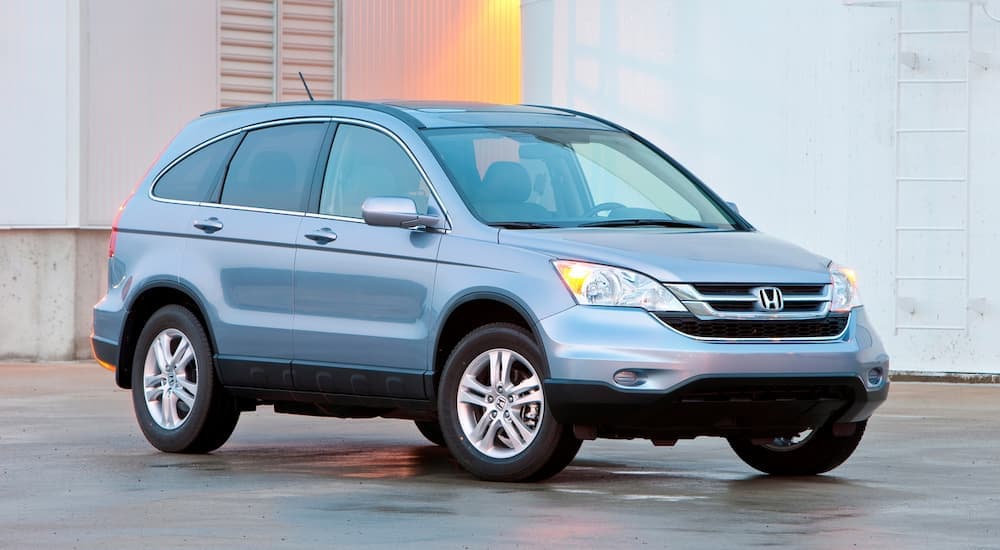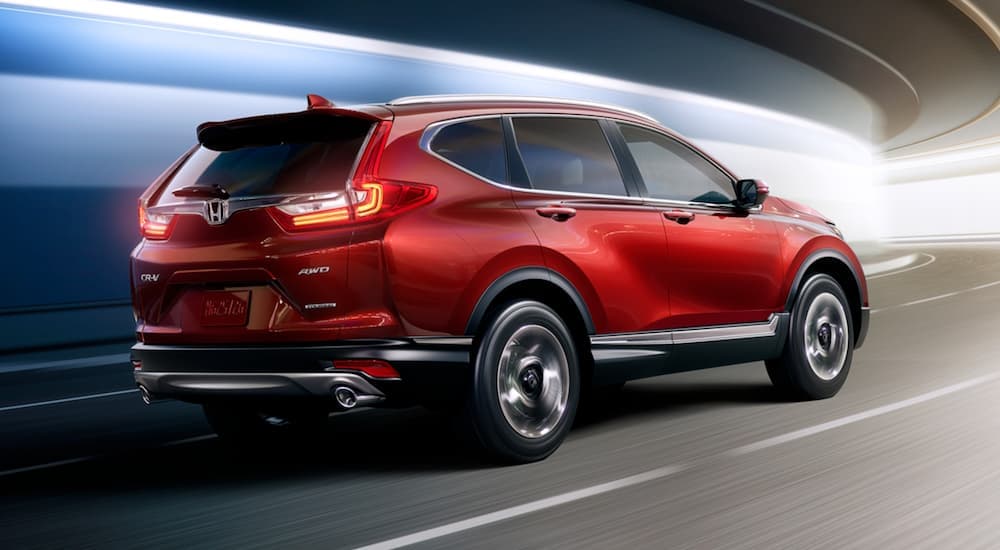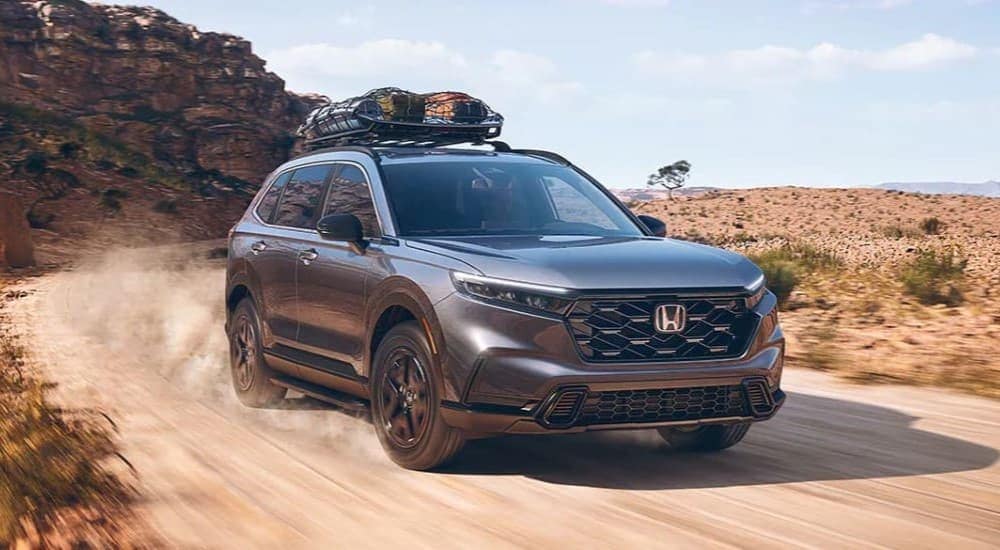
Can you name the trendsetter for compact SUVs? While land yachts like the full-size Suburban are credited with launching the popularity of SUVs, models like the CR-V are renowned for proving bigger isn’t always better. Honda transformed the automotive landscape when it debuted the CR-V as its “Comfortable Runabout Vehicle,” which is renowned for its versatility, functionality, engaging driving demeanor, and remarkable efficiency. Today, as your used Honda dealer near Calhoun, you can expect those same characteristics and more from every CR-V on our lot.
But what makes the CR-V such a fan favorite? Honda’s reputation is stellar, proving its ingenuity by building versatile vehicles that can log hundreds of thousands of miles without breaking a sweat. This longevity, combined with the efficiency and functionality of a compact powerhouse like the Honda CR-V, is nearly impossible to find beyond the Honda lineup. The CR-V’s rich history proves as much. Here’s a closer look at that history and the CR-V’s evolution from a compact utility vehicle to a modern marvel...
First Generation (1997-2001): The Birth of a Bestseller
Honda answered a unique need in the industry when it debuted the first-generation CR-V in 1997. The CR-V was a new breed, offering the handling and responsiveness of a sedan and the spaciousness and versatility of an SUV. There wasn’t anything else like it, which Honda capitalized on by adding the segment’s first four-wheel double wishbone suspension for exceptional agility and smooth handling in any condition.
The CR-V’s initial appeal was widespread, with Honda proving the compact SUV was ready for anything by adding Real-Time 4WD. The fully automatic four-wheel drive system guaranteed the CR-V’s prowess on any terrain and offered all-season and all-weather confidence, complemented by the SUV’s 8.1-inch ground clearance. Combined with the CR-V’s 2.0L four-cylinder engine, this configuration set the stage for engaging and efficient performance, giving drivers the best of both worlds.
This first-generation CR-V quickly became a fan-favorite for drivers across the country, from Calhoun to California. Honda fueled that popularity with several critical updates throughout the generation, like tuning the powertrain to increase output, adding a two-wheel drive option, and offering more amenities and technologies like heated front seats and the Honda Satellite-Linked Navigation System. Of course, these updates set the stage for Honda to up the ante again in 2002.
Second Generation (2002-2006): Bigger and More Powerful
Honda returned to the drawing board for the CR-V’s second generation, building the SUV on the all-new Global Compact Platform to increase its size in nearly every dimension. With a larger footprint and a more expansive cabin, the second-generation CR-V offered more comfort and versatility, advanced features, and a more engaging powertrain. Once again, drivers responded in kind, with the SUV earning top honors from Car and Driver.
Most notably, the second generation introduced more power under the hood without affecting the CR-V’s efficiency. This unique combination meant more savings for drivers navigating their commutes from Calhoun to Ruston or Monroe. Honda struck the perfect balance with its i-VTEC 2.4L engine with variable timing control and lift electronic control, which increased the CR-V’s output to 160 hp and 162 lb-ft of torque.
By the end of the generation, Honda launched its Safety for Everyone campaign and made the CR-V the program’s mascot. The CR-V introduced major safety updates in 2005, including front and side curtain airbags. It also rolled off Honda’s production line with Vehicle Stability Assist and Traction Control, instilling more confidence and control in the driver’s seat.
Third Generation (2007-2011): Sleeker and More Luxurious
Honda’s Comfortable Runabout Vehicle became even more attractive in 2007, thanks to a more modern design and streamlined silhouette after Honda moved the spare tire from the rear to the underbody. This simple design change added to the CR-V’s functionality, making it easier to access the rear tailgate and load groceries, luggage, and other cargo.
Of course, Honda didn’t stop there. The third-generation CR-V made history with its first-ever automatic transmission. It also introduced several other firsts and updates, including an electronic drive-by-wire system and a real-time all-wheel drive system for heightened performance in every season and condition. The updates translated to an increased output of 166 hp, which jumped to 180 hp in 2010 when Honda fine-tuned the engine even further.
The CR-V’s increased power output also ushered in more comforts and conveniences, mainly via Honda’s Advanced Compatibility Engineering Body Structure. Designed to improve ride quality and handling, the CR-V’s ACE Body Structure is still a staple of the SUV today, renowned for actively managing energy in frontal collisions to heighten driver safety. Other, more noticeable updates of this generation include luxuries like dual-zone automatic climate control, a power-adjustable driver’s seat, steering wheel-mounted audio controls, and a six-speaker entertainment system with a six-disc CD player on 2011 models.

Fourth-Generation (2012-2016): The Connectivity Era
The CR-V entered its Bluetooth era in 2012 when Honda introduced more tech to keep drivers connected and engaged. The fourth-generation CR-V rolled off the production line with standard Bluetooth HandsFreeLink capability, dual digital displays, and a multi-angle rearview camera for enhanced visibility around the SUV. Honda continuously added to the CR-V’s tech-savvy packaging, introducing the Honda Sensing suite in 2015.
This suite gave the CR-V another incredible advantage over rivals because it featured a Collision Mitigation Braking System, Lane Keeping Assist System, Forward Collision Warning, and Adaptive Cruise Control for a more relaxing experience on highways like I-20 in and around Calhoun.
The fourth-generation CR-V continued its tenure as a popular model, thanks to Honda’s efforts to continuously improve and evolve it. For example, the CR-V gained a larger 7.0-inch touchscreen display in 2015, making this generation the first to offer technology comparable to a smartphone. The CR-V’s powertrain also saw a boost in output, with Honda introducing an all-new 2.4L engine that produced 181 lb-ft of torque for exceptional responsiveness and handling at any speed.
Fifth-Generation (2017-2022): Turbocharged Performance
Running errands in Eureka or venturing beyond the Calhoun city limits has never been more appealing than behind the wheel of a CR-V. The fifth-generation CR-V breeds some of the most popular models on our used lot because this generation introduces drivers to a turbocharged engine that effortlessly balances output and efficiency. Honda perfects that balance with a 1.5L turbocharged inline four-cylinder with dual-valve timing control and direct fuel injection. By mating the engine to a continuously variable automatic transmission (CVT), the CR-V produces 190 hp and 179 lb-ft of torque.
In addition to its turbocharged heartbeat, the fifth-generation CR-V introduced many cutting-edge features and conveniences, from a hands-free-access power tailgate to Apple CarPlay and Android Auto integration. This generation also has the most expansive driver assistance tech working behind the scenes ever since Honda made its Honda Sensing suite standard across the CR-V’s lineup and introduced more advanced tools, like Road Departure Mitigation, Adaptive Cruise Control with Low-Speed Follow, a Blind Spot Information System, Driver Attention Monitor, Auto High Beams, and a Rear Cross-Traffic Monitor.
Most notably, commuters fell in love with the CR-V Hybrid, which debuted in 2020. Powered by Honda’s award-winning hybrid system, the CR-V Hybrid answered the need (and continues to do so) for a modern, more efficient road warrior with a penchant for performance. The unique combination of its dual-motor system and near-instant torque makes the CR-V Hybrid immensely popular, saving drivers more money at the pump without compromise.
Sixth Generation (2023-Present): More of Everything
As Honda’s most beloved SUV since the late 1990s, the sixth-generation CR-V celebrates its incredible legacy and rich history by giving drivers more of everything. Bigger, better equipped, and more powerful than ever, the sixth-generation CR-V is perfect for Calhoun drivers looking for a modern marvel. Honda delivers tenfold, with the sixth-generation CR-V proving it’s at home in town, on the highway, and off the pavement, blending its capacity to handle your workweek and weekends.
The 2023 CR-V lives up to the hype courtesy of its all-new dual-motor hybrid system that produces 247 lb-ft of near-instant torque and 204 hp. Drivers can still reap the benefits of Honda’s 1.5L turbocharged four-cylinder, which gives the CR-V plenty of power, delivering 179 lb-ft of torque and 190 hp with its smooth-shifting CVT. This power is even more enjoyable because of the CR-V’s tech-savvy and well-equipped cabin, which features expansive digital displays, wireless phone charging, leather seating, and advanced driver assistance tools that guarantee a transformative and engaging experience in the driver’s seat.

The Ultimate Compact Utility Vehicle: The Honda CR-V
Whether you’re looking for the perfect SUV to handle your commute along I-20 to Monroe or you need a versatile SUV to fit your family comfortably, you’ll find everything you want and more in the CR-V. Honda’s exceptional CR-V showcases the brand’s efforts to think outside the box and design an SUV that doesn’t solely meet our needs but also exceeds our expectations.
Because of this, shopping for the perfect CR-V becomes an exciting endeavor because you can confidently shop across generations, knowing you’re investing in a vastly versatile and long-lasting SUV packed with high value and stellar features.
